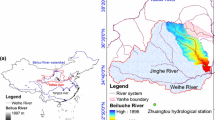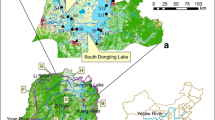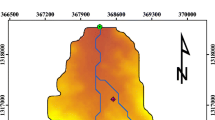Abstract
The identification of critical source areas (CSAs) and critical source periods (CSPs) are essential prerequisites for cost-effective practices of non-point source (NPS) pollution control. A simple empirical tool combining Export Coefficient Model (ECM) and a Geographic Information Systems (GIS)-based weighting scheme of watershed heterogeneity was proposed to estimate annual and monthly phosphorus loss, to identify critical source areas and periods, and to assess pollution control practices. The GIS-based weighting scheme was developed to represent the transport potential of runoff to move phosphorus from the land surfaces to waters, as a supplement to the source-based ECM. The empirical tool was applied to the Dianchi Lake watershed of China. The results showed that the total phosphorus loss from NPS in 2008 was 352.3 tons. The agricultural land was recognized as the largest and the most spatially various source type. The lakeside plain and the terraces of the watershed were identified as CSAs, which generated more than 90 % of non-point phosphorus. The early part of wet season (from May to August) was the CSPs, when about 70 % of non-point phosphorus was lost. The reduction of phosphorus fertilizers and the vegetated buffer strips (VBS) were effective in controlling phosphorus loss from NPS in the watershed. A reduction of 20 % in phosphorus fertilizer application combined with the set-up of VBS in both riparian area of the main watercourses and the lakeside areas would decrease 25 % of phosphorus loss.






Similar content being viewed by others
References
Shen, Z. Y., Liao, Q., Hong, Q., & Gong, Y. W. (2012). An overview of research on agricultural non-point source pollution modelling in china. Separation and Purification Technology, 84, 104–111. doi:10.1016/j.seppur.2011.01.018.
Drolc, A., & Koncan, J. Z. (2002). Estimation of sources of total phosphorus in a river basin and assessment of alternatives for river pollution reduction. Environment International, 28(5), 393–400. doi:10.1016/S0160-4120(02)00062-4.
Shen, Z. Y., Hong, Q., Chu, Z., & Gong, Y. W. (2011). A framework for priority non-point source area identification and load estimation integrated with APPI and PLOAD model in Fujiang Watershed, China. Agricultural Water Management, 98(6), 977–989. doi:10.1016/j.agwat.2011.01.006.
Chen, H., Teng, Y., & Wang, J. (2013). Load estimation and source apportionment of nonpoint source nitrogen and phosphorus based on integrated application of SLURP model, ECM, and RUSLE: a case study in the Jinjiang River, China. Environmental Monitoring and Assessment, 185(2), 2009–2021. doi:10.1007/s10661-012-2684-z.
Endreny, T. A., & Wood, E. F. (2003). Watershed weighting of export coefficients to map critical phosphorous loading areas. Journal of the American Water Resources Association, 39(1), 165–181. doi:10.1111/j.1752-1688.2003.tb01569.x.
Matias, N. G., & Johnes, P. J. (2012). Catchment phosphorous losses: an export coefficient modelling approach with scenario analysis for water management. Water Resources Management, 26(5), 1041–1064. doi:10.1007/s11269-011-9946-3.
Borah, D., & Bera, M. (2003). Watershed-scale hydrologic and nonpoint-source pollution models: review of mathematical bases. Transactions of ASAE, 46(6), 1553–1566.
Cools, J., Broekx, S., Vandenberghe, V., Sels, H., Meynaerts, E., Vercaemst, P., et al. (2011). Coupling a hydrological water quality model and an economic optimization model to set up a cost-effective emission reduction scenario for nitrogen. Environmental Modelling & Software, 26(1), 44–51. doi:10.1016/j.envsoft.2010.04.017.
Zhang, T. (2010). A spatially explicit model for estimating annual average loads of nonpoint source nutrient at the watershed scale. Environmental Modeling and Assessment, 15(6), 569–581. doi:10.1007/s10666-010-9225-3.
Johnes, P. J. (1996). Evaluation and management of the impact of land use change on the nitrogen and phosphorus load delivered to surface waters: the export coefficient modelling approach. Journal of Hydrology, 183(3–4), 323–349. doi:10.1016/0022-1694(95)02951-6.
Winter, J. G., & Duthie, H. C. (2000). Export coefficient modeling to assess phosphorus loading in an urban watershed. Journal of the American Water Resources Association, 36(5), 1053–1061. doi:10.1111/j.1752-1688.2000.tb05709.x.
Ma, X., Li, Y., Zhang, M., Zheng, F. Z., & Du, S. (2011). Assessment and analysis of non-point source nitrogen and phosphorus loads in the three gorges reservoir area of Hubei Province, China. Science of the Total Environment, 412, 154–161. doi:10.1016/j.scitotenv.2011.09.034.
Malve, O., Tattari, S., Riihimaki, J., Jaakkola, E., Voss, A., Williams, R., et al. (2012). Estimation of diffuse pollution loads in Europe for continental scale modelling of loads and in-stream river water quality. Hydrological Processes, 26(16), 2385–2394. doi:10.1002/hyp.9344.
Ding, X. W., Shen, Z. Y., Hong, Q., Yang, Z. F., Wu, X., & Liu, R. M. (2010). Development and test of the export coefficient model in the upper reach of the Yangtze River. Journal of Hydrology, 383(3–4), 233–244. doi:10.1016/j.jhydrol.2009.12.039.
May, L., House, W. A., Bowes, M., & McEvoy, J. (2001). Seasonal export of phosphorus from a lowland catchment: upper River Cherwell in Oxfordshire, England. Science of the Total Environment, 269(1–3), 117–130. doi:10.1016/s0048-9697(00)00820-2.
Hickey, M. B. C., & Doran, B. (2004). A review of the efficiency of buffer strips for the maintenance and enhancement of riparian ecosystems. Water Quality Research Journal of Canada, 39(3), 311–317.
Hoffmann, C. C., Kjaergaard, C., Uusi-Kamppa, J., Hansen, H. C. B., & Kronvang, B. (2009). Phosphorus retention in riparian buffers: review of their efficiency. Journal of Environmental Quality, 38(5), 1942–1955. doi:10.2134/jeq2008.0087.
Duchemin, M., & Hogue, R. (2009). Reduction in agricultural non-point source pollution in the first year following establishment of an integrated grass/tree filter strip system in southern Quebec(Canada). Agriculture, Ecosystems & Environment, 131(1–2), 85–97. doi:10.1016/j.agee.2008.10.005.
Roberts, W. M., Stutter, M. I., & Haygarth, P. M. (2012). Phosphorus retention and remobilization in vegetated buffer strips: a review. Journal of Environmental Quality, 41(2), 389–399. doi:10.2134/jeq2010.0543.
Jakeman, A., & Hornberger, G. (1993). How much complexity is warranted in a rainfall-runoff model? Water Resources Research, 29(8), 2637–2649.
Beven, K. J., & Kirkby, M. J. (1979). A physically based, variable contributing area model of basin hydrology/Un modèle à base physique de zone d'appel variable de l'hydrologie du bassin versant. Hydrological Sciences Bulletin, 24(1), 43–69. doi:10.1080/02626667909491834.
Anderson, M. G., & Burt, T. P. (1990). Process studies in hillslope hydrology: an overview. In M. G. Anderson & T. P. Burt (Eds.), Process studies in hillslope hydrology. New York: Wiley.
Beven, K. (1995). TOPMODEL. In V. P. Singh (Ed.), Computer models of watershed hydrology (pp. 627–668). Colorado: Water Resources Publications.
Uusi-Kamppa, J., Braskerud, B., Jansson, H., Syversen, N., & Uusitalo, R. (2000). Buffer zones and constructed wetlands as filters for agricultural phosphorus. Journal of Environmental Quality, 29(1), 151–158.
Syversen, N. (2005). Effect and design of buffer zones in the Nordic climate: the influence of width, amount of surface runoff, seasonal variation and vegetation type on retention efficiency for nutrient and particle runoff. Ecological Engineering, 24(5), 483–490. doi:10.1016/j.ecoleng.2005.01.016.
Ziegler, A. D., Tran, L. T., Giambelluca, T. W., Sidle, R. C., Sutherland, R. A., Nullet, M. A., et al. (2006). Effective slope lengths for buffering hillslope surface runoff in fragmented landscapes in northern Vietnam. Forest Ecology and Management, 224(1–2), 104–118. doi:10.1016/j.foreco.2005.12.011.
Yang, S. H., & Yang, G. H. (1992). Preliminary study on the structure of land utilization and its ecological evaluation in the Dianchi Lake watershed. Journal of Yunnan University, 02, 202–210.
Li, H. E., & Zhuang, Y. T. (2003). The export coefficient modeling approach for load prediction of nutrients from non-point source and its application. Journal of Xi'an University Technology, 19, 307–312.
Yang, W. L., & Yang, S. H. (1998). Study on the divisions of non-point pollution sources in the Dianchi Lake basin. Journal of Lake Science, 03, 55–60.
Acknowledgments
The work was supported by the National Natural Science Foundation of China (41471433 and 41001333); the Central Public-interest Scientific Institution Basal Research Fund (2014-37); the Youth Chenguang Project of Science and Technology of Wuhan City (201150431072); and Hubei Province Natural Science Foundation of China (2011CDB404).
Author information
Authors and Affiliations
Corresponding authors
Ethics declarations
Conflict of Interest
The authors declare that they have no competing interests.
Human and Animal Rights and Informed Consent
The research do not involve any human participants or animals. All the authors consent to submit this manuscript to Environmental Modeling & Assessment.
Rights and permissions
About this article
Cite this article
Li, S., Zhang, L., Du, Y. et al. Evaluating Phosphorus Loss for Watershed Management: Integrating a Weighting Scheme of Watershed Heterogeneity into Export Coefficient Model. Environ Model Assess 21, 657–668 (2016). https://doi.org/10.1007/s10666-016-9499-1
Received:
Accepted:
Published:
Issue Date:
DOI: https://doi.org/10.1007/s10666-016-9499-1




